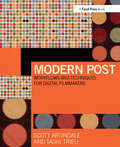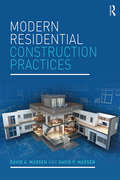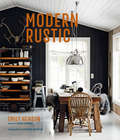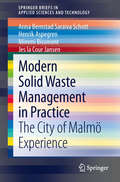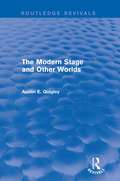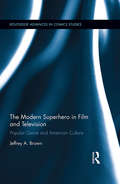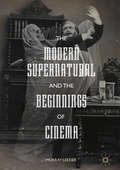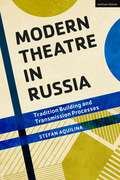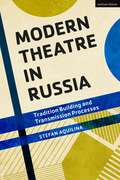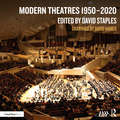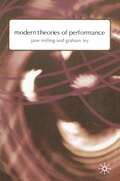- Table View
- List View
Modern Post: Workflows and Techniques for Digital Filmmakers
by Scott Arundale Tashi TrieuWith the shift from film to digital, today’s filmmakers are empowered by an arsenal of powerful, creative options with which to tell their story. Modern Post examines and demystifies these tools and workflows and demonstrates how these decisions can empower your storytelling. Using non-technical language, authors Scott Arundale and Tashi Trieu guide you through everything you should consider before you start shooting. They begin with a look to past methodologies starting with traditional film techniques and how they impact current trends. Next they offer a look at the latest generation of digital camera and capture systems. The authors move on to cover: * Preproduction- what camera is best for telling your story and why, budgeting for post* Production- on-set data management, dailies, green screen, digital cinematography* Postproduction- RAW vs. compressed footage, editing, visual effects, color correction, sound and deliverables including DCP creation The book features cutting-edge discussion about the role of the digital imaging technician (DIT), how you can best use the Cloud, motion graphics, sound design, and much more. Case studies show you these solutions being applied in real-world situations, and the companion website features videos of techniques discussed in the book, as well as timely updates about technological changes in the landscape. www.focalpress.com/cw/arundale
Modern Quilting: From First Stitches to Finishing Touches
by Cait Moreton-LisleThis practical book is for everyone who wants to make bright, bold, modern quilts. It celebrates the essence of this joyful craft and explains it through clear step-by-step guides. Whether you are a complete novice or an experienced quilter, this book will show you everything you need to develop your quilting expertise and will inspire you to explore the exciting world of modern quilting design.
Modern Religious Architecture in Germany, Ireland and Beyond: Influence, Process and Afterlife since 1945
by Kathleen James-Chakraborty Lisa GodsonModernity and religion are not mutually exclusive. Setting German and Irish church, synagogue and mosque architecture side by side over the last century highlights the place for the celebration of the new within faiths whose appeal lies in part in the stability of belief they offer across time. Inspired by radically modern German churches of the 1920s and 1930s, this volume offers new insights into designers of all three types of sacred buildings, working at home and abroad. It offers new scholarship on the unknown phenomenon of mid-century ecclesiastical architecture in sub-Saharan Africa by Irish designers; a critical appraisal of the overlooked Frank Lloyd Wright-trained Andrew Devane and an analysis of accommodating difficult pasts and challenging futures with contemporary synagogue and mosque architecture in Germany. With a focus on influence and processes, alongside conservationists and historians, it features critical insights by the designers of some of the most celebrated contemporary sacred buildings, including Niall McLaughlin who writes on his multiple award-winning Bishop Edward King Chapel and Amandus Sattler, architect of the innovative Herz-Jesu-Kirche, Munich.
Modern Religious Architecture in Germany, Ireland and Beyond: Influence, Process and Afterlife since 1945
by Kathleen James-Chakraborty Lisa GodsonModernity and religion are not mutually exclusive. Setting German and Irish church, synagogue and mosque architecture side by side over the last century highlights the place for the celebration of the new within faiths whose appeal lies in part in the stability of belief they offer across time. Inspired by radically modern German churches of the 1920s and 1930s, this volume offers new insights into designers of all three types of sacred buildings, working at home and abroad. It offers new scholarship on the unknown phenomenon of mid-century ecclesiastical architecture in sub-Saharan Africa by Irish designers; a critical appraisal of the overlooked Frank Lloyd Wright-trained Andrew Devane and an analysis of accommodating difficult pasts and challenging futures with contemporary synagogue and mosque architecture in Germany. With a focus on influence and processes, alongside conservationists and historians, it features critical insights by the designers of some of the most celebrated contemporary sacred buildings, including Niall McLaughlin who writes on his multiple award-winning Bishop Edward King Chapel and Amandus Sattler, architect of the innovative Herz-Jesu-Kirche, Munich.
Modern Residential Construction Practices
by David A. Madsen David P. MadsenModern Residential Construction Practices provides easy-to-read, comprehensive and highly illustrated coverage of residential building construction practices that conform to industry standards in the United States and Canada. Each chapter provides complete descriptions, real-world practices, realistic examples, three-dimensional (3D) illustrations, and related tests and problems. Chapters cover practices related to every construction phase including: planning, funding, permitting, codes, inspections, site planning, excavation, foundations and flatwork, floors, walls, roofs, finish work and cabinetry; heating, ventilating, and air conditioning (HVAC); electrical, and plumbing. The book is organized in a format that is consistent with the process used to take residential construction projects from preliminary concept through all phases of residential building construction. An ideal textbook for secondary and college level construction programs, the book is packed with useful features such as problems that challenge students to identify materials and practices, along with research and document information about construction materials and practices, useful summaries, key notes, a detailed glossary, and online materials for both students and educators.
Modern Residential Construction Practices
by David A. Madsen David P. MadsenModern Residential Construction Practices provides easy-to-read, comprehensive and highly illustrated coverage of residential building construction practices that conform to industry standards in the United States and Canada. Each chapter provides complete descriptions, real-world practices, realistic examples, three-dimensional (3D) illustrations, and related tests and problems. Chapters cover practices related to every construction phase including: planning, funding, permitting, codes, inspections, site planning, excavation, foundations and flatwork, floors, walls, roofs, finish work and cabinetry; heating, ventilating, and air conditioning (HVAC); electrical, and plumbing. The book is organized in a format that is consistent with the process used to take residential construction projects from preliminary concept through all phases of residential building construction. An ideal textbook for secondary and college level construction programs, the book is packed with useful features such as problems that challenge students to identify materials and practices, along with research and document information about construction materials and practices, useful summaries, key notes, a detailed glossary, and online materials for both students and educators.
Modern Rustic
by Emily HensonRustic isn’t what it used to be. Gone are the days when rustic style meant fusty dried flower arrangements, antlers over a stone fireplace and acres of tartan.At its heart, the modern rustic look celebrates the fabric of a home, from the roof beams to the brickwork. This style revels in earthy colours and rich textures; in natural materials such as wood and stone; and the ruggedly handsome bones of a building. In this book, stylist Emily Henson and writer Joanna Simmons first lead you through the Elements of the Modern Rustic look. Pure Rustic elegantly blends clean lines with muted shades of grey. Bohemian Rustic mixes texture and pattern with lush colour, while Pop Rustic teams raw wood with pops of neon and tongue-in-cheek artworks. Retro Rustic, meanwhile, brings a relaxed feel, showcasing beaten-up leather armchairs and brick floors. In Details, textiles, furniture, fabric and display are explored, while Living Spaces shows how Modern Rustic style translates beautifully to every room in the house.
Modern Scottish Painting
by J D FergussonIn 1939, Scottish artist and sculptor J.D. Fergusson was commissioned to write a fully illustrated book on modern Scottish painting. The Second World War made this difficult and the first edition of Modern Scottish Painting was published in 1943 without illustrations. This new edition – edited, introduced and annotated by Alexander Moffat and Alan Riach – finally brings Fergusson’s project to fruition, illustrating the argument with colour reproductions of Fergusson’s own work. Moffat and Riach frame Fergusson’s important art manifesto for the 21st-century reader, illuminating his views on modern art as he explores questions of technique, education, form and what it means for a painting to be truly modern. Fergusson relates these aspects of modern painting to Scottishness, showing what they mean for Scottish identity, nationalism, independence and the legacy that puritanical Calvinism has left on Scottish art – a particular concern for Fergusson given his recurring subject matter of the female nude.
Modern Solid Waste Management in Practice: The City of Malmö Experience (SpringerBriefs in Applied Sciences and Technology)
by Anna Bernstad Saraiva Schott Henrik Aspegren Mimmi Bissmont Jes la Cour JansenThis book focuses on sustainable solid waste management in an urban context and gives an example of how a modern city can work with waste management for increased sustainability in close cooperation with the academy. The book describes challenges which the city is facing and presents a case on how these can be tackled based on several research and development projects performed in the City of Malmö over the last decade. In these projects, the city has worked as a test bed for new solutions, developed with and evaluated by the university. The projects and evaluations of the same have been developed with a multi-dimensional approach; including technical aspects, resource efficiency, economic parameters, information strategies towards households and user friendliness. Methods used for evaluation are presented in a comprehensive way together with a discussion on how results from performed evaluations have affected the solid waste management policy making in the city. The book describes a bridging over a commonly noticed gap between research on the one hand and policy making and technical management on the other. Several examples are given on how academy and real life and full-scale developments in the city can have a fruit-full collaboration, where feed-back from evaluation of made changes are used for continuous improvements – at the same time as the actual needs from the city forces the academy to develop new methods for evaluations and develop new solutions to previously un-known or un-addressed problems.
Modern Spiritualism and Scottish Art: Scots, Spirits and Séances, 1860-1940
by Michelle FootThis pioneering account of Modern Spiritualism in late 19th and early 20th-century Scotland is a compelling history of the international movement's cultural impact on Scottish art. From spirit-mediums creating séance art to mainstream artists of the Royal Scottish Academy, this exposition reveals for the first time the extent of Spiritualist interest in Scotland. With its interdisciplinary scope, Modern Spiritualism and Scottish Art combines cultural and art history to explore the ways in which Scottish art reflected Spiritualist beliefs at the turn of the 20th century. More than simply a history of the Spiritualist cause and its visual manifestations, this book also provides a detailed account of scepticism, psychical research, and occulture in modern Scotland, and the role that these aspects played in informing responses to Spiritualist ideology.Utilising extensive archival research, together with in-depth analyses of overlooked paintings, drawings and sculpture, Michelle Foot demonstrates the vital importance of Spiritualist art to the development of Spiritualism in Scotland during the 19th century. In doing so, the book highlights the contribution of Scottish visual artists alongside better-known Spiritualists such as Arthur Conan Doyle and Daniel Dunglas Home.
Modern Spiritualism and Scottish Art: Scots, Spirits and Séances, 1860-1940
by Michelle FootThis pioneering account of Modern Spiritualism in late 19th and early 20th-century Scotland is a compelling history of the international movement's cultural impact on Scottish art. From spirit-mediums creating séance art to mainstream artists of the Royal Scottish Academy, this exposition reveals for the first time the extent of Spiritualist interest in Scotland. With its interdisciplinary scope, Modern Spiritualism and Scottish Art combines cultural and art history to explore the ways in which Scottish art reflected Spiritualist beliefs at the turn of the 20th century. More than simply a history of the Spiritualist cause and its visual manifestations, this book also provides a detailed account of scepticism, psychical research, and occulture in modern Scotland, and the role that these aspects played in informing responses to Spiritualist ideology.Utilising extensive archival research, together with in-depth analyses of overlooked paintings, drawings and sculpture, Michelle Foot demonstrates the vital importance of Spiritualist art to the development of Spiritualism in Scotland during the 19th century. In doing so, the book highlights the contribution of Scottish visual artists alongside better-known Spiritualists such as Arthur Conan Doyle and Daniel Dunglas Home.
The Modern Stage and Other Worlds (Routledge Revivals)
by Austin E. QuigleyModern plays are strikingly diverse and, as a result, any attempt to locate an underlying unity between them encounters difficulties: to focus on what they have in common is often to overlook what is of primary importance in particular plays; to focus on their differences is to note the novelty of the plays without increasing their accessibility. In this study, first published in 1985, Austin E. Quigley takes as his paradigm case the relationship between the world of the stage and the world of the audience, and explores various modes of communication between domains. He asks how changes in the structure of the drama relate to changes in the structure of the theatre, and changes in the role of the audience. Detailed interpretations of plays by Pinero, Ibsen, Strindberg, Brecht, Ionesco, Beckett and Pinter question principles about the modern theatre and establish links between drama structure and theatre structure, theme, and performance space.
The Modern Stage and Other Worlds (Routledge Revivals)
by Austin E. QuigleyModern plays are strikingly diverse and, as a result, any attempt to locate an underlying unity between them encounters difficulties: to focus on what they have in common is often to overlook what is of primary importance in particular plays; to focus on their differences is to note the novelty of the plays without increasing their accessibility. In this study, first published in 1985, Austin E. Quigley takes as his paradigm case the relationship between the world of the stage and the world of the audience, and explores various modes of communication between domains. He asks how changes in the structure of the drama relate to changes in the structure of the theatre, and changes in the role of the audience. Detailed interpretations of plays by Pinero, Ibsen, Strindberg, Brecht, Ionesco, Beckett and Pinter question principles about the modern theatre and establish links between drama structure and theatre structure, theme, and performance space.
The Modern Station: New Approaches to Railway Architecture
by Brian EdwardsAn exciting new generation of railway architecture has emerged in Europe and elsewhere over the past decade. This book explains the reasons for the renaissance of the station as a building type and the current changes it is undergoing. The functional, social and technical factors which shape railway architecture are examined. As stations are essential elements of sustainable development, the environmental benefits of railways are also discussed. Essential guidance is provided for those who design, commission or manage railway stations. By drawing on technical design manuals and examples of recent stations (many designed by leading architects) the book gives help and instruction to all those with an interest in the future of railway architecture.
The Modern Station: New Approaches to Railway Architecture
by Brian EdwardsAn exciting new generation of railway architecture has emerged in Europe and elsewhere over the past decade. This book explains the reasons for the renaissance of the station as a building type and the current changes it is undergoing. The functional, social and technical factors which shape railway architecture are examined. As stations are essential elements of sustainable development, the environmental benefits of railways are also discussed. Essential guidance is provided for those who design, commission or manage railway stations. By drawing on technical design manuals and examples of recent stations (many designed by leading architects) the book gives help and instruction to all those with an interest in the future of railway architecture.
The Modern Steel House
by Neil JacksonThis book provides a comprehensive survey of Modern Movement houses constructed with steel frames. Arranged chronologically and thematically, it traces the development over the last seventy years of steel houses in Europe, Australia and the United States, with special reference to London, Paris, Sydney and Los Angeles and to the work elsewhere of Mies van der Rohe, Philip Johnson and Jean Prouve. Examples of steel houses from around the world demonstrate that steel structures can provide a better quality of life within a cleaner, lighter home environment.
The Modern Steel House
by Neil JacksonThis book provides a comprehensive survey of Modern Movement houses constructed with steel frames. Arranged chronologically and thematically, it traces the development over the last seventy years of steel houses in Europe, Australia and the United States, with special reference to London, Paris, Sydney and Los Angeles and to the work elsewhere of Mies van der Rohe, Philip Johnson and Jean Prouve. Examples of steel houses from around the world demonstrate that steel structures can provide a better quality of life within a cleaner, lighter home environment.
The Modern Superhero in Film and Television: Popular Genre and American Culture (Routledge Advances in Comics Studies)
by Jeffrey A. BrownHollywood’s live-action superhero films currently dominate the worldwide box-office, with the characters enjoying more notoriety through their feature film and television depictions than they have ever before. This book argues that this immense popularity reveals deep cultural concerns about politics, gender, ethnicity, patriotism and consumerism after the events of 9/11. Superheroes have long been agents of hegemony, fighting for abstract ideals of justice while overall perpetuating the American status quo. Yet at the same time, the book explores how the genre has also been utilized to question and critique these dominant cultural assumptions.
The Modern Superhero in Film and Television: Popular Genre and American Culture (Routledge Advances in Comics Studies)
by Jeffrey A. BrownHollywood’s live-action superhero films currently dominate the worldwide box-office, with the characters enjoying more notoriety through their feature film and television depictions than they have ever before. This book argues that this immense popularity reveals deep cultural concerns about politics, gender, ethnicity, patriotism and consumerism after the events of 9/11. Superheroes have long been agents of hegemony, fighting for abstract ideals of justice while overall perpetuating the American status quo. Yet at the same time, the book explores how the genre has also been utilized to question and critique these dominant cultural assumptions.
The Modern Supernatural and the Beginnings of Cinema
by Murray LeederThis study sees the nineteenth century supernatural as a significant context for cinema’s first years. The book takes up the familiar notion of cinema as a “ghostly,” “spectral” or “haunted” medium and asks what made such association possible. Examining the history of the projected image and supernatural displays, psychical research and telepathy, spirit photography and X-rays, the skeletons of the danse macabre and the ghostly spaces of the mind, it uncovers many lost and fascinating connections. The Modern Supernatural and the Beginnings of Cinema locates film’s spectral affinities within a history stretching back to the beginning of screen practice and forward to the digital era. In addition to examining the use of supernatural themes by pioneering filmmakers like Georges Méliès and George Albert Smith, it also engages with the representations of cinema’s ghostly past in Guy Maddin’s recent online project Seances (2016). It is ideal for those interested in the history of cinema, the study of the supernatural and the pre-history of the horror film.
Modern Theatre in Russia: Tradition Building and Transmission Processes
by Stefan AquilinaWhat did modern theatre in Russia look like and how did it foreground tradition building and transmission processes? The book challenges conventional historiographical approaches by weaving contemporary theories on cultural transmission into its historical narrative. It argues that processes of transmission – training spaces, acting manuals, photographic evidence, newspaper reports, international networking, informal encounters, cultural memories – contribute to the formation and consolidation of theatre traditions. Through English translations of rare Russian sources, the book expounds on:*side-lined material on Stanislavsky, including his relationship with German actor Ludwig Barnay, use of improvisation at the First Studio, and rehearsal practices for Artists and Admirers (1933);*Valentin Smyshlaev's acting manual The Technique to Process Stage Performance and the creation of hybrid practices;*proletarian theatre as an amateur-professional combination and force in the transformation of everyday life, as seen in the Proletkult's volume Art at the Workers' Clubs; *Meyerhold's Borodin Studio as an early example of Practice as Research, his European tour of 1930, and international persona as depicted in newspapers published in the West; and*Asja Lacis's work with children, which contributes to current efforts to address the gender imbalance that is often characteristic of modernism.This historical-theoretical investigation is combined with practical exercises that provide a more experiential understanding of the modern performance realities involved. In this way, the book speaks not only to theatre scholars and historians, but also to students and practitioners engaged in practical work.
Modern Theatre in Russia: Tradition Building and Transmission Processes
by Stefan AquilinaWhat did modern theatre in Russia look like and how did it foreground tradition building and transmission processes? The book challenges conventional historiographical approaches by weaving contemporary theories on cultural transmission into its historical narrative. It argues that processes of transmission – training spaces, acting manuals, photographic evidence, newspaper reports, international networking, informal encounters, cultural memories – contribute to the formation and consolidation of theatre traditions. Through English translations of rare Russian sources, the book expounds on:*side-lined material on Stanislavsky, including his relationship with German actor Ludwig Barnay, use of improvisation at the First Studio, and rehearsal practices for Artists and Admirers (1933);*Valentin Smyshlaev's acting manual The Technique to Process Stage Performance and the creation of hybrid practices;*proletarian theatre as an amateur-professional combination and force in the transformation of everyday life, as seen in the Proletkult's volume Art at the Workers' Clubs; *Meyerhold's Borodin Studio as an early example of Practice as Research, his European tour of 1930, and international persona as depicted in newspapers published in the West; and*Asja Lacis's work with children, which contributes to current efforts to address the gender imbalance that is often characteristic of modernism.This historical-theoretical investigation is combined with practical exercises that provide a more experiential understanding of the modern performance realities involved. In this way, the book speaks not only to theatre scholars and historians, but also to students and practitioners engaged in practical work.
Modern Theatres 1950–2020
by David Staples; David HamerModern Theatres 1950–2020 is an investigation of theatres, concert halls and opera houses in Asia, Europe, the Middle East and North and South America. The book explores in detail 30 of the most significant theatres, concert halls, opera houses and dance spaces that opened between 1950 and 2010. Each theatre is reviewed and assessed by experts in theatre buildings, such as architects, acousticians, consultants and theatre practitioners, and illustrated with full-colour photographs and comparative plans and sections. A further 20 theatres that opened from 2009 to 2020 are concisely reviewed and illustrated. An excellent resource for students of theatre planning, theatre architecture and architectural design, Modern Theatres 1950–2020 discusses the role of performing arts buildings in cities, explores their public and performances spaces and examines the acoustics and technologies needed in a great building.
Modern Theatres 1950–2020
by David StaplesModern Theatres 1950–2020 is an investigation of theatres, concert halls and opera houses in Asia, Europe, the Middle East and North and South America. The book explores in detail 30 of the most significant theatres, concert halls, opera houses and dance spaces that opened between 1950 and 2010. Each theatre is reviewed and assessed by experts in theatre buildings, such as architects, acousticians, consultants and theatre practitioners, and illustrated with full-colour photographs and comparative plans and sections. A further 20 theatres that opened from 2009 to 2020 are concisely reviewed and illustrated. An excellent resource for students of theatre planning, theatre architecture and architectural design, Modern Theatres 1950–2020 discusses the role of performing arts buildings in cities, explores their public and performances spaces and examines the acoustics and technologies needed in a great building.
Modern Theories of Performance: From Stanislavski to Boal
by Jane Milling Graham LeyThe modern era in the theatre is remarkable for the extraordinary role and influence of theoretical practitioners, whose writings have shaped our sense of the possibilities and objectives of performance. This study offers a critical exploration of the theoretical writings of key modern practitioners from Stanlislavski to Boal. Designed to be read alongside primary source material, each chapter offers not only a summary and exposition of these theories, but a critical commentary on their composition as discourses. Close scrutiny of the cultural context and figurative language of these important, and sometimes difficult, texts yields fresh insight into the ideas of these practitioners.
